Artopia: May 2007 Archives
Isaac Abrams, Cosmic Orchid, 1967
Day-Glo Days
You should see, if you can, "Summer of Love: Art of the Psychedelic Era," now at the Whitney Museum, N.Y.C., to September 16. This first-time survey of the art so many would like to forget comes full-blown, paradoxes and all, from the Tate Liverpool, curated by its director Christoph Grunenberg.
Certainly one strand of the art-history braid belongs to the spiritual in art. The two types of spiritual art are the propagandistic and the instrumental, the latter concerned with creating spiritual states, not just reporting, supporting or imposing previous ones. Historically, the two types are confused and/or intertwined.
It may be true that the making of, as well as the more obvious viewing of, stained glass windows caused ecstatic states, although I know of no records of such. We sort of know what happened when Jakob Boehme saw a glint of sunlight on a pewter bowl. The download began: "Though flesh and blood cannot conceive or apprehend the being of God, but the spirit only when enlightened and kindled from God...." (The Aurora, 1612). But we do not know what might have happened when any less extraordinary shoemaker saw his first Rose Window.
Clerics and laity may have been forced into joy, but were the designers and tradesmen who made the windows transported during their labors? I'd guess monks responsible for illuminated manuscripts, like the Book of Kells, might have had a hard time keeping their feet on the ground. And if a few Irish calligraphers were transported, why not glassworkers and even stone masons? An important and little-noted function of art is how it transforms its maker, not how it teaches or pleases or changes viewers. From this point of view, the knitting is more important than the sweater; the weaving is more important than the cloth.
Abdul Mati Klarwein, View of Aleph Sanctuary, 1963-1971
The Rewrite Marches On
Although a great deal of psychedelia may have been drug induced or drug inspired, as in a certain literary tradition (think de Quincey and Coleridge), Grunenberg makes the point that Psychedelic Art has been written out of the official art history now subsumed by the Minimal/Pop/Conceptual axis. This MPC alliance is not as strange as once might have been supposed, since each banished the hand.
Given the '60s art-world consumption of mind-altering substances and the inviolable tradition of alcohol abuse, the exclusion of Psychedelic Art is not about anti-drug puritanism but about power and dividing up slices of the economic pie. Surely the prohibition is not about taste, considering the bad taste endemic in academia and the world of galleries and museums.
What was or is so dangerous about swirling colors? Big Brother and the Holding Company? Be-In posters? Groovy nudies and spiritual symbols, about astrology and mythology? Like Grunenberg, I too think we should take another look at this despised and repressed art. The "Summer of Love" makes that possible.
Politics is pushed aside. There is no clear articulation of the Free Speech vs. Hippie (or Berkeley vs. Haight-Ashbury) divide. No real presence of the antiwar and black, women's and gay liberation movements, all of which had a lasting impact. Nevertheless, the formalist curatorial strategy does provide a certain clarity. Psychedelic Art, I should say, has not been repressed because it was anti-political (as both the Left and the New Left accused) or because it seemed to promote drugs. We all know what happened to Janis. She OD'd and it wasn't on Southern Comfort. By 1967, the dubious use of drugs as a spiritual tool became the use of drugs as recreation, opening the door to heroin and speed. The Summer of Love became the Bummer of Love.
No, Psychedelic Art got the kibosh because there was no room for it in the single-strand art history that dominates art discourse. The single-strand approach is a great sales pitch because it makes today's newest commodity seem inevitable, like the Dictatorship of the Proletariat or the Old Testament leading to the New.
In Grunenberg's catalog essay, he suggests that Psychedelic Art was too populist, too popular, too commercial, too decorative, too kitschy. I would add that Psychedelic Art was too "spiritual" and there was no academically sanctioned precedent for positioning spiritual art in the art market. Formally, Art Brut was the closest category, but what later became Outsider Art (with its own lively market now collapsing into Folk Art) was then owned by wine merchant Jean Dubuffet.
If some of the most characteristic psychedelic works were posters, album covers, and light shows, how could Leo Castelli make a living out of that? The graphic art is now highly collectible and Joplin's psychedelic Porsche is priceless. The light shows have come back to haunt us, re-jiggered as projected or time-based art.
Verner Panton, Phantasy Landscape Visiona, 1970-2000
All You Need Is a Little Bit of LSD
"Summer" embraces everything from walk-in meditation rooms, graphic art, light shows, films, sculpture, paintings (yes, even paintings). Also, as if to emphasize the curatorial formalism, we are jolted by a spectacular Lynda Benglis poured-latex floor piece, California Minimalist John McCracken's psychedelic forays, a triptych by political-Conceptualist Adrian Piper, design luminary Verner Panton's Phantasy Landscape Visiona II, and a Paul Jenkins stain-painting exercise. I never would have thought of Benglis, Jenkins, and Panton as psychedelic. Nor had I any inkling that McCracken and Piper, like the rest of the art world, had experimented with mind-altering substances.
More significant are paintings by nearly forgotten artists such as the under-appreciated painter Isaac Abrams and Abdul Mati Klarwein, whose walk-in trip-room (Aleph Sanctuary, 1963-71) is a high point of the exhibition -- no pun intended. And if you go to the Klarwein website you will see that the curator did pick the high point of this artist's checkered career. Also, on the Klarwein website I found this to share with you:
Anybody can classify me as they wish. In the fifties I was classified as an illustrator, even though my work consisted of paintings. And in the sixties my work was classified as psychedelic. So I took psychedelics to find out what it was all about. I found out I couldn't paint on them. I'll tell you about a funny episode. Jean Houston and Robert Masters put together a book called Psychedelic Art in the sixties, and they came to me... And they asked me, "What kind of psychedelics do you take when you're painting?" And I said, "I don't take anything when I'm painting. When I take psychedelics I get very horny, and I start going out to nightclubs and cruising." (laughter)
So they said, "Well, we can't put you in the book." I freaked out, because I wasn't in any book yet (laughter), and I said, "But I get my ideas when I'm high." And they said, "Alright, we'll put you in the book." Next they asked me for the names of other psychedelic painters, and I gave them a whole list, including Fuchs. I called them all up right away, and I told them, "Tell them that you're taking psychedelics!" And they all got in the book. (laughter)
And I certainly have to mention that the sound and light walk-in created by La Monte Young and Marian Zazeela's, Music and Light Box (1967-8) should have been given the entire third floor. Young is the founder of music Minimalism, and after he worked through his Zen koan music events, his Minimalism was extreme, as is audible here. With the group called Inside the Dream Syndicate (Tony Conrad, John Cale, and others) he went on to put a patent on the loud, really loud. Entering the concert hall, as I once wrote, was like walking into a solid pool of heavy water. You either woke up or went deaf.
Will we ever have a cross-media Minimalism exhibition that would include not only the sculpture we already know, but Young, Tony Conrad films, the architecture of Luis Barragan, cuisine minceur, Aram Saroyan's one-word poems, and Scott Burton's furniture? Will we ever mine the friendship between Young and Walter de Maria, Phil Glass and Sol LeWitt?
Of course, we may also read Psychedelic Art, like it or not, as anti-Minimalism with a vengeance, besting a thousand times over what was to be packaged as post-Minimalism --- hence the oddity of the inclusion of Benglis, who has usually been deemed a more orthodox post-Minimalist, i.e., Minimalism with soft materials. Grunenberg's most radical remark is that his exhibition will "challenge the myth of coherent movements and individual styles." Well, that's certainly loosening the bit, increasing the bite. He has a point. We tend to lop off art and art careers that do not fit marketing categories. Art careers get rewritten too, but usually not for the better. Each artist, each style has to be the equivalent of a sound bite.
* * *
Finally, now I can announce that I am not alone in my push for re-imagining or re-conceptualizing art history as a braid rather than a single, evolutionary strand. Artist and critic Mark Staff Brandl, obviously an Artopian, sent me a link from Switzerland to his review of David Carrier's book The Aesthetics of Comics. I suggest reading the whole thing, but here's a pertinent excerpt:
The future of both fine and comic art, to follow Carrier's suggestions, might not be posthistorical, but rather polyhistorical. This is an portentous expansion of art and art history. If I may be so bold, I would offer the author a useful metaphor for his philosophy. Media theorist Christian Doelker has supplied an alternative reading of the word text. While most literary theorists use the term to prejudicially favour reading over seeing, Doelker traces the term back to its root in weaving or a cable. This is a highly evocative image. I picture, in a very Wittgensteinian manner, an interwoven mass of filaments, some longer, some shorter, each a "history," each independent to an extent, yet touching on various others, some ending only to begin again farther on, all travelling nonetheless in certain concert...... Suggestively, Carrier.... offers us a philosophy which sees history as a cable of integrated stories; we have simply focused far too long on only one strand. Again to use Doelker's terminology, we could have an art history which is plurogenic (multistrand), as opposed to...monogenic (single strand) conceptions. This is a promising description of history, a welcome alternative to the end-tales now so predominant.
Obviously great minds think alike. I will leave aside for the moment the need to re-imagine history in general, and time itself.
FOR AN AUTOMATIC ARTOPIA ALERT WHEN NEW ESSAYS ARE POSTED NOTIFY: perreault@aol.com
JOHN PERREAULT INTERVIEWED, PODCAST ON WPS1.
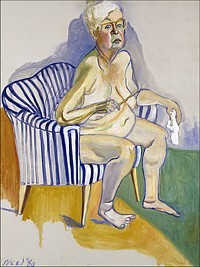
Alice Neel, Self-Portrait, 1980
Go Ask Alice, If You Dare
Have I said enough about maverick painter Alice Neel? You can read what I wrote in 2000, by going to my website . It's an insider's view, since I recount my experience as a nude victim for that merciless realist. On the other hand, I have heard my little essay is sometimes used as a prime example of storytelling as art criticism.
For another angle on Neel (1900-1984), one might turn to someone in her biological family rather than her art-world family. A documentary by her grandson Andrew Neel has recently been released. It's called simply Alice Neel, now showing in New York at the small Cinema Village movie house, and a trailer is available at the film's website. It skillfully blends new and archival footage to tell the Neel story: bohemian rebellion, free love, death and madness; poverty and empathy; and then, with a little help from her friends and a boost from '60s feminism - triumph. You know, it's just your same old, same old. But have you seen your grandma on Johnny Carson? Did your grandma paint you naked?
I usually hate artist bio-docs. This one is an exception, possibly because the basic material is so fascinating, and there are crucial twists and turns. Neel was dramatic without being self-dramatizing. Well, perhaps she was a little self-dramatizing. So is her grandson.
In some old footage, you see pre-pubescent Andrew jumping around nude in front of his grandma while she is trying to paint, which doesn't bother her at all. And later in the film, we witness the director's verbal altercation with his father, Hartley. Andrew is off-camera running the camera. And, let's put it this way, words are exchanged. Clearly our director/cinematographer has the Alice Neel gene, best described as an eye plus temperament. The smart thing here, as he admits, is that without the family dirty laundry and the director's presence, the film would turn into sentimental goo.
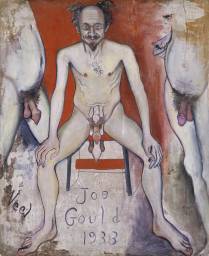
Neel, Joe Gould, 1933
Alice Doesn't Live Here Anymore
As in his granny's paintings, there is a dark side expressed in Andrew's film. Late-night visitors pass through the sleeping room of young Hartley and Richard. The latter was apparently mistreated by Alice's benefactor, John Rothchild. And did I mention Richard's proclamation into his nephew's lens that you won't find anyone more right wing than himself? He was a teenage fan of Nixon, but Alice - the boys called her Alice -- successfully forbade him from even mentioning that villain's name in her presence. Hartley, who has more camera time, laments the toll of his mom's bohemianism. Before their birth she, like many other lucky artists, was on the WPA and then later, as a single mother, was helped by welfare. Hartley became a doctor; Richard, a lawyer.
Neel once told me, loaded brush in hand, she had hoped that at least one of them would turn out to be a ballet dancer. No such luck.
It is, of course, a nice feel-good peak that Neel in the end had a big exhibition at the Whitney and was on Carson's talk show twice. The talk-show sequences here are amusing indeed. But at what cost fame? Hartley, looking a bit depressed, has to admit that she was a good mother -- although unable to protect Richard from being kicked under the table by Rothchild.
I think that because Neel was doing what she wanted to do, which was to paint all sorts of riff-raff -- saints, sinners, and even eventually critics and museum directors - she was a better mother (and person) than if she had lived a horrid life of creative frustration. And took it out on her sons.
She chronicled the human comedy. And the tragedy. Late in life she had the devil in her eye. All her emperors had no clothes; and neither did anyone else. Everyone - sons, grandchildren, pregnant daughter-in-law, the Fuller Brush salesman - was naked to her gaze. I always tell people she was my real grandmother, my art grandmother.
After all, because of Neel's nude portrait of me, now in the permanent collection of the Whitney Museum, I had my Warholian 15 minutes of fame. The photo editor at the Village Voice, without consulting me, used it to illustrate my September 27, 1973, review of Neel's exhibition at the Graham Gallery.
The shock was not only the hairy frontal nudity, but the appearance that I might have chosen the illustration myself, never mind that I was writing about an exhibition that included the painting. Those were the so-called good old days. And Gregory Battcock, Jill Johnston and myself, like everyone else, were trying to make as much trouble as possible. Criticism had too many rules. Hadn't Walt Whitman written his own review of Leaves of Grass and published it in the Brooklyn Eagle, where he worked?
What people did not know was that I had no say about the photos. If you look back at the Voice art pages in that period you will usually see a disconnect between my writings and the photos. As a poet, I knew how to compensate with brief word-pictures of what I found more interesting. The photos-- as "a way of getting more art coverage" someone explained -- usually showed coy artists peeking through or around their awful sculptures, not the Earth Art, Conceptual Art, and Streetworks I was inserting into the art discourse.
That photo of my naked portrait and its bold display is probably why in a recent review of the film Alice Neel, a writer referred to the notorious painting of John Perreault. Or did the writer mean the painting of the notorious John Perreault?
In 2000, when there was a second Alice Neel survey at the Whitney, the postcard of my nude portrait was the gift-shop best-seller. As I explained in a gallery talk at the museum, my 15 minutes of fame was now reduced to five minutes. Now I can report that the unidentified flash of the naked me in Alice Neel is now my two-second moment of worldwide fame. Fame like everything else has speeded up.
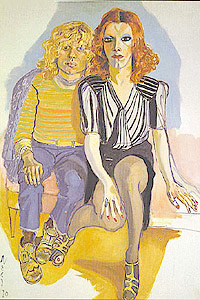
Neel, Rita Red and Jackie, 1979.
Alice's Revenge
What we need now is a full-scale, scripted biography of Neel. I usually hate Hollywood, arty biographies. Lust for Life? Disgusting. But Neel's life, with all those opportunities for satire, drama, and social commentary, would be something worth seen acted out.
My art grandmother Alice Neel was a jolly Stalinist to the end, if you can imagine such a thing. I think she liked that my real great-uncle had been an organizer for the Wobblies and a bigamist. But maybe not. The Wobblies did not fit the party line.
And, what a sharp tongue! She used to say at lectures that if only she had a wife like X (a realist painter) she'd be famous now too. She once got Warhol superstar Jackie Curtis into the stuffy University Club in full drag, "to have lunch and to see the paintings." She told me, they were thrown out.
And she loved to gossip; she was a wicked, wicked gossip. She claimed to have painted the painting that allowed a certain famous art critic to get on the WPA as a painter. "And to this day he has never written about me," I remember her complaining.
Which famous art critic? My lips are sealed.
But once, just once, I did best her.
John, she said to me on the telephone, "I've finally done it I've painted the lowest of the low. I've painted a woman who gets paid for peeing on men." "But," I replied, "Alice, you once told me bankers were the lowest of the low." Pause. "You know, you're right. They are."
But here I think the most important thing for my Alice Neel Hollywood Movie is the casting. Although they never receive Academy Awards, casting directors are the unsung "writers" of many a movie. Choosing the right actors creates the characters. Of course, getting them to sign up is another problem, but we won't go there. The Alice Neel Story has cultural value, as well as sex, violence, and a Rocky ending to a rocky life. Besides, who wouldn't pay $12 to see a Norman Rockwell grandmother curse and talk about evil art world figures and corporate clowns, while painting all kinds of colorful characters in her Upper Westside living room, as the world goes up in smoke.
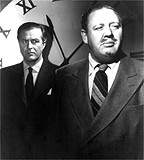
Ray Milland and Charles Laughton, The Big Clock, 1948.
Alice in Hollywood
Susan Sarandon has already played Alice, brilliantly, in The Secret Life of Joe Gould, so she might not want to repeat the role. And if the artist Louise Patterson in poet Kenneth Fearing's classic noir novel The Big Clock is Neel, then Elsa Lanchester played her too - in the first film version, directed by John Farrow in 1948.
Neel had painted poet and pulpster Fearing. They shared left-wing political views, and she considered him a friend. In The Big Clock book - now shelved in my local B&N in literature, not mysteries -- the artist has four children and not two; and a lover burns all of her art, not just the drawings and watercolors. In real life, dope fiend Kenneth Doolittle only burned the drawings and watercolors and then went on to slash the paintings. But Patterson's laugh and bitterness, bred of lack of attention, are much like Neel's.
The layered story is told through monologues. Here's a quote from the Alice/Louise chapter, recounting the artist's encounter with an investigator:
I looked at him through a haze of rage. He was another picture burner. I could tell it just by looking at his white, stuffy face. Another one of those decent, respectable maniacs who'd like nothing better than to take a butcher knife and slash canvases, slap them with paint, burn them. By God, he looked exactly like Pete. No, Pete's way had been to use them to cover up broken window panes, plug up draughts, and stop leaks in the ceiling. He was more the official type. His method would be to bury them in an authorized warehouse somewhere, destroy the records, and let them stay there forever.
Kenneth Fearing, The Big Clock, 1946.Reprinted by Orion Books, London. Page 146.
This is sort of what happened to Neel's WPA paintings. A plumbing company did indeed buy them to wrap pipes. Years later, someone I knew once found one nailed to a hot dog stand.
Perhaps by emphasizing Neel's dark side, Fearing was taking his revenge for her wicked 1935 portrait, in which he seems to be smirking over life and death. In any case, he has Alice/Louise willfully not identify a man she thinks is a murderer because she hopes to get one of her long-lost paintings back from him. He is a collector or her art, and that seems to excuse everything.
The "hero," George Stroud (drunkard, art collector, adulterer, and editor of a magazine within a Time/Life-type corporation), refers to the painting of a pair of hands holding a coin as The Temptation of St. Judas. This is perhaps a projection, but what or whom has Stroud betrayed by working for a publishing empire? Fearing himself sometimes wrote for Time magazine. Patterson calls the painting Study in Fundamentals. It sounds like something the real Neel might have painted in the '30s, which would indeed, by 1945, have ended up in a Third Avenue "antique" shop, on sale for a steal.
Cast of Characters
Young Alice: Drew Barrymore..... will be the film that confirms she can act; just think Poison Ivy.
Mature Alice: Angela Lansbury....has the looks, the humor and the spunk.
Carlos Enriquez, the rich Cuban Neel ran away with to escape Moore College of Art in Philadelphia and/or to escape the Main Line: Adrien Brody.... actually looks like Neel's portrait of Enriques.
Kenneth Doolittle: Robert Downey Jr.... because he knows how to chew the scenery.
Joe Gould, legendary author of the legendary "an oral history of our time": Jack Nicholson..... has that Joe Gould twinkle, although, as far as I know, does not have three penises, as in Neel's painting.
Jose Santiago, Richard's father: Antonio Banderas...has to be handsome enough for Neel to pursue, and he is.
John Rothchild , travel agent and life-long friend; John Malkovitch....no explanation required, aside from the fact that he is the best villain ever and the most droll. He looks like Rothchild too.
Richard Neel: Jude Law..... would have to dye or un-dye his hair, but otherwise cool and perfect.
Hartley Neel: John Malkovitch...no explanation required aside from the fact that it would be fun to see the actor play two different parts in the same film.
Nancy Neel (Richard's wife): Felicity Huffman... could really nail down Nancy's patience and fortitude in attending to her mother-in-law.
Andy Warhol: Rufus Wainwright... would have to bleach his hair, but he could really do Warhol's voice.
John Perreault: Nicholas Cage...he's hairy enough and we have the same eyes.
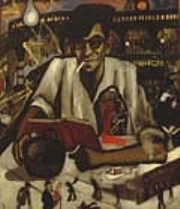
Neel, Kenneth Fearing, 1935
But who will play Kenneth Fearing, who not only wrote The Big Clock, but also
Aphrodite Metropolis:
Harry loves Myrtle--He has strong arms, from the warehouse,
And on Sunday when they take the bus to emerald meadows he doesn't say:
"What will your chastity amount to when your flesh withers in a little while?"
No,
On Sunday, when they picnic in emerald meadows the look at the Sunday
paper.
GIRL SLAYS BANKER-BETRAYER
They spread it around on the grass
BATH-TUB STIRS JERSEY ROW
And then they sit down on it, nice.
Harry doesn't say "Ziggin's Ointment for withered flesh,
Cures thousands of men and women of motes, warts, red veins,
flabby throat, scalp and hair diseases,
Not expensive, and fully guaranteed."
No,
Harry says nothing at all,
He smiles,
And they kiss in the emerald meadows on the Sunday paper.
Who will play other Neel painting subjects such as Henry Geldzahler, Walter Gutman, Jackie Curtis, Annie Sprinkle, Meyer Schapiro, Frank O'Hara, Clement Greenberg's daughter, Harold Rosenberg, Robert Smithson, Dorothy "I'll scratch her eyes out" Pearlstein, Linda Nochlin, Gregory Battcock?
And who will have the nerve and the verve to direct Alice's Revenge?
Want to be e-mailed when new essays are posted? Contact: perreault@aol.com
AJ Ads
AJ Blogs
AJBlogCentral | rssculture
Terry Teachout on the arts in New York City
Andrew Taylor on the business of arts & culture
rock culture approximately
Laura Collins-Hughes on arts, culture and coverage
Richard Kessler on arts education
Douglas McLennan's blog
Dalouge Smith advocates for the Arts
Art from the American Outback
For immediate release: the arts are marketable
No genre is the new genre
David Jays on theatre and dance
Paul Levy measures the Angles
Judith H. Dobrzynski on Culture
John Rockwell on the arts
Jan Herman - arts, media & culture with 'tude
dance
Apollinaire Scherr talks about dance
Tobi Tobias on dance et al...
jazz
Howard Mandel's freelance Urban Improvisation
Focus on New Orleans. Jazz and Other Sounds
Doug Ramsey on Jazz and other matters...
media
Jeff Weinstein's Cultural Mixology
Martha Bayles on Film...
classical music
Fresh ideas on building arts communities
Greg Sandow performs a book-in-progress
Exploring Orchestras w/ Henry Fogel
Harvey Sachs on music, and various digressions
Bruce Brubaker on all things Piano
Kyle Gann on music after the fact
Greg Sandow on the future of Classical Music
Norman Lebrecht on Shifting Sound Worlds
publishing
Jerome Weeks on Books
Scott McLemee on books, ideas & trash-culture ephemera
theatre
Wendy Rosenfield: covering drama, onstage and off
Chloe Veltman on how culture will save the world
visual
Public Art, Public Space
Regina Hackett takes her Art To Go
John Perreault's art diary
Lee Rosenbaum's Cultural Commentary
Tyler Green's modern & contemporary art blog
